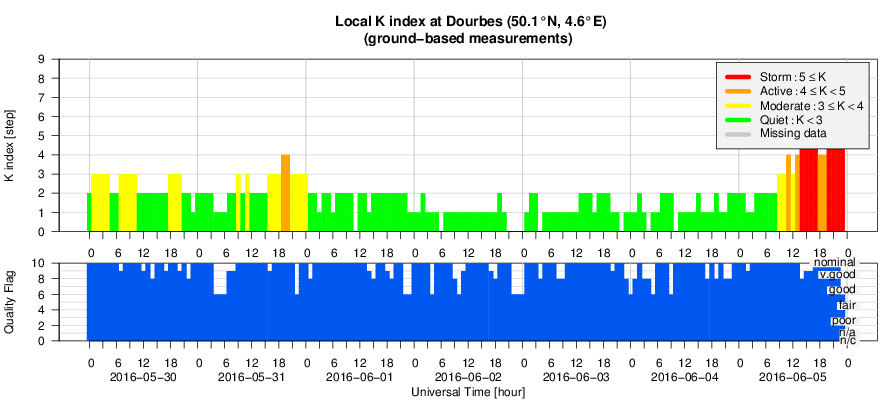- Table of Content
- 1.Spotless days
- 2.ESWW13 - Contr...
- 3.PROBA2 Observa...
- 4.Review of sola...
- 5.The Estimated ...
- 6.Review of geom...
- 7.Geomagnetic Ob...
- 8.Review of iono...
- 9.Future Events
- 10.New documents ...
2. ESWW13 - Contributions to sessions
3. PROBA2 Observations (30 May 2016 - 5 Jun 2016)
4. Review of solar activity
5. The Estimated International Sunspot Number
6. Review of geomagnetic activity
7. Geomagnetic Observations at Dourbes (30 May 2016 - 5 Jun 2016)
8. Review of ionospheric activity (30 May 2016 - 5 Jun 2016)
9. Future Events
10. New documents in the European Space Weather Portal Repository
Spotless days
The already very low solar activity of the last few months ended into a downright traumatic experience for the solar observers when, starting on 3 June, the Sun became totally devoid of its so familiar speckles. Indeed, from 3 till 7 June, no sunspots were observed, and the daily estimated sunspot number (http://sidc.oma.be/silso/ ) was at comatose levels (flat "0") for 5 consecutive days. The SDO/HMI (http://sdo.gsfc.nasa.gov/ ) imagery underneath shows the solar disk on 2, 5 and 8 June. The group that disappears behind the west limb is NOAA 2551, and the one that is visible on 8 June is NOAA 2552.
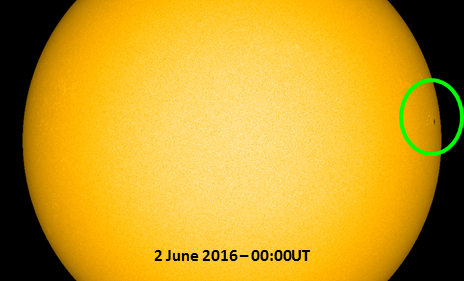
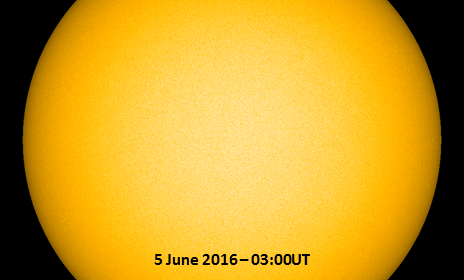
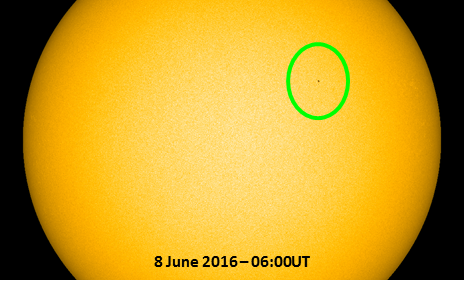
Together with an isolated spotless day on 17 July 2014 (see the related news item at http://www.stce.be/news/261/welcome.html ), these were the first spotless days since the most recent solar cycle maximum early 2014. They are ominous signs that the current cycle is in its declining phase, and that we are gradually approaching the next solar cycle minimum. That minimum is expected around 2020, but it is still to early to make any further prognosis or comparison with the previous very deep minimum in 2008-2009 (see this 2009 news item at http://www.stce.be/node/227 ). Also, brief periods with strong solar activity remain possible for certainly the next 2 years. Indeed, prior to the previous minimum in December 2008, many X-class flares were recorded in January 2005, September 2005 and December 2006.
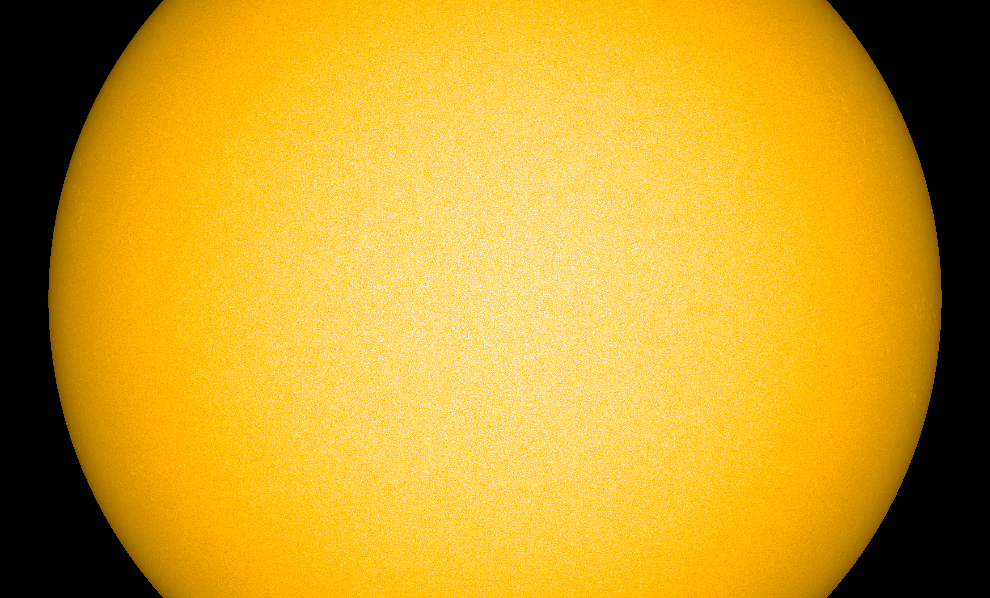
ESWW13 - Contributions to sessions
Participants are welcome to submit a contribution to one or more sessions listed here:
Space weather applications of global neutron monitor network
Space environment effects on humans in Space and on Earth
Space weather impacts, socio-economic costs and benefits of mitigation
SSA Space Weather Service Network
Space weather needs and opportunities from upcoming space missions
Space Weather effects on GNSS and precise positioning
Enhanced Space Weather Monitoring Systems
Model Metrics, Verification and Validation
Space Climate
Spacecraft operations and space weather
Space Systems Development and Operations: Dealing with Space Weather and Space Climate Effects
Machine learning and statistical inference techniques
Flares, coronal mass ejections and solar energetic particles: Space Weather Impact
Best practice in transitioning existing space science tools to operational SW prediction systems
Developing new space weather tools: Bridging between the fundamental science and operations
The success of IHY and ISWI projects in the development of Space Weather
Don't forget the deadline: June 13, included
Submission is done through the website http://www.stce.be/esww13/program/sessions.php
Happy submission!
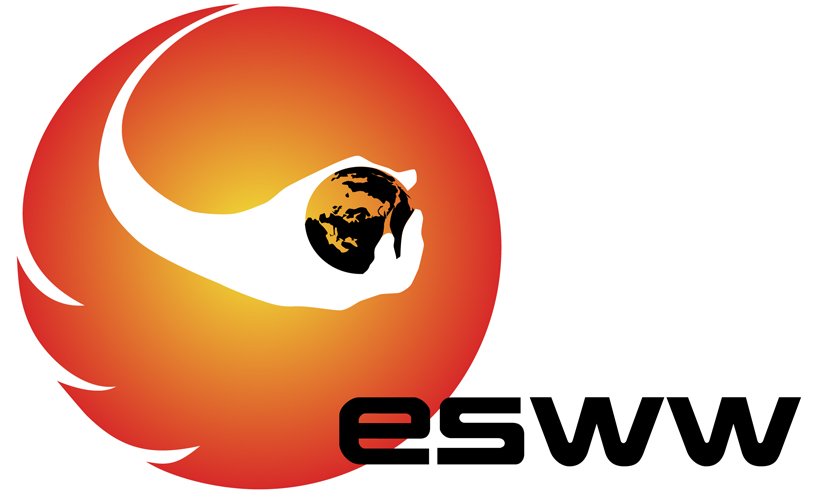
PROBA2 Observations (30 May 2016 - 5 Jun 2016)
Solar Activity
Solar flare activity fluctuated between very low and low during the week.
In order to view the activity of this week in more detail, we suggest to go to the following website from which all the daily (normal and difference) movies can be accessed:
http://proba2.oma.be/ssa
This page also lists the recorded flaring events.
A weekly overview movie can be found here (SWAP week 323).
http://proba2.oma.be/swap/data/mpg/movies/weekly_movies/weekly_movie_2016_05_30.mp4
Details about some of this week's events, can be found further below.
Monday May 30
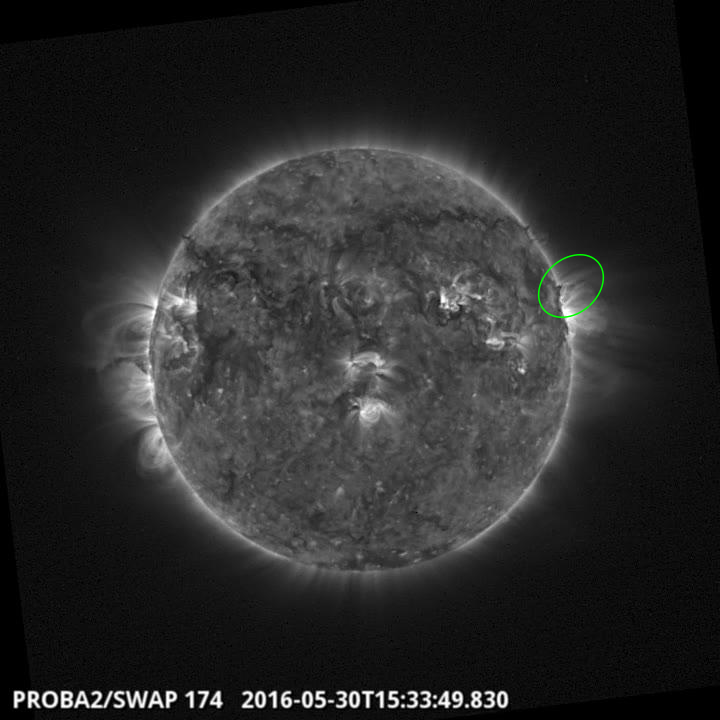
An eruption was observed by SWAP on the west limb of the Sun on 2016May30 at 15:33 UT
Find a movie of the events here (SWAP movie)
http://proba2.oma.be/swap/data/mpg/movies/20160530_swap_movie.mp4
Wednesday Jun 01
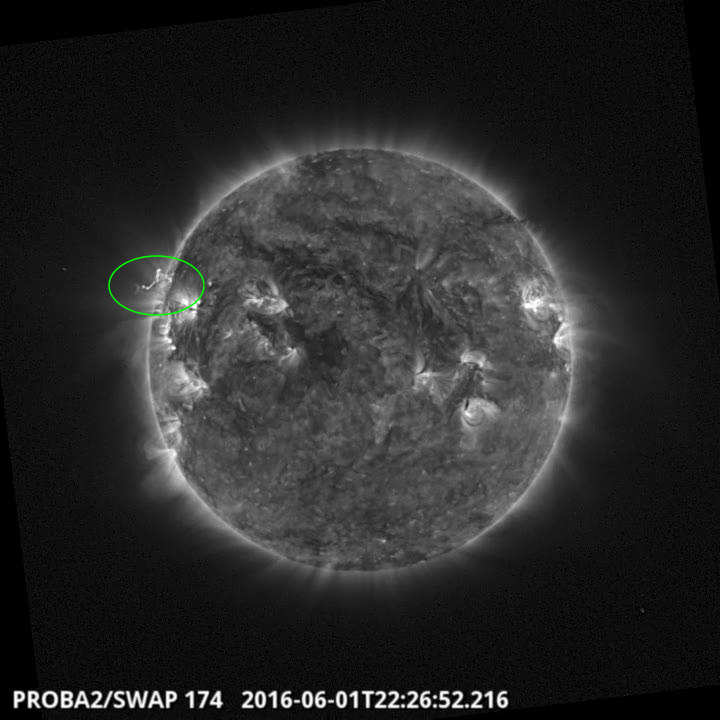
An eruption was observed by SWAP on the east limb of the Sun on 2016Jun01 at 22:26 UT
Find a movie of the events here (SWAP movie)
http://proba2.oma.be/swap/data/mpg/movies/20160601_swap_movie.mp4
Review of solar activity
The solar activity was very low during the full week. During the first few days there were three active regions present: NOAA active regions 2549, 2550 and 2551, of which2550 produced at its best two C1-flares.
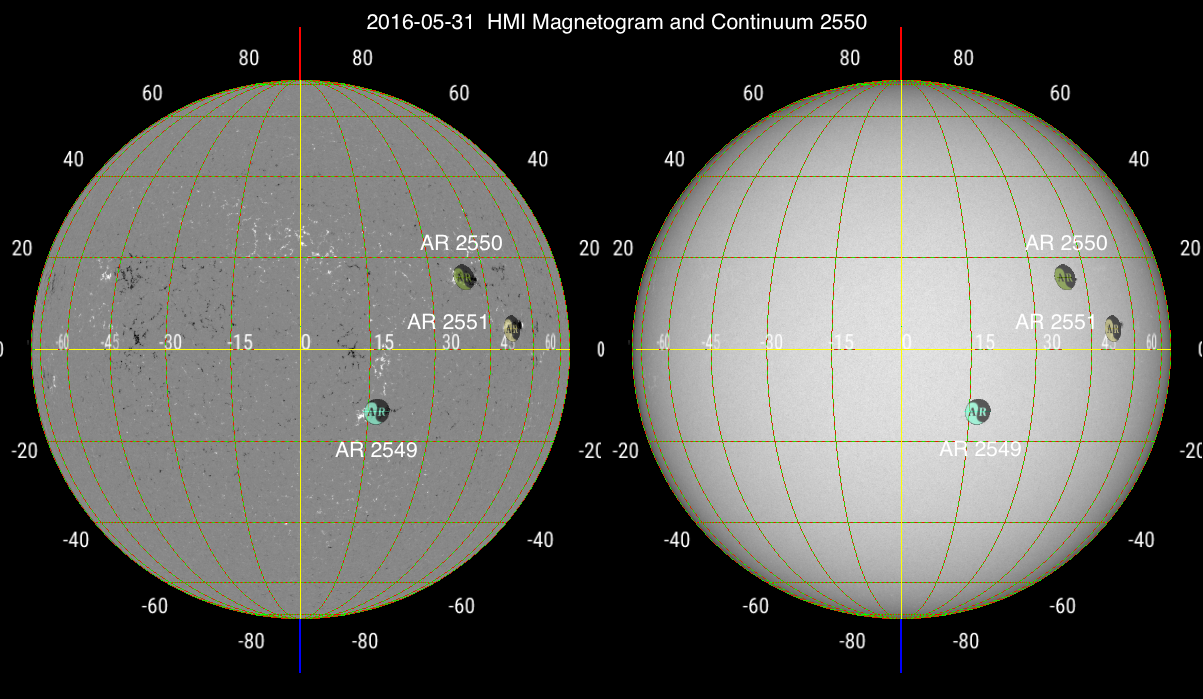
A long duration B7-flare associated with a prominence eruption on June 1 was the only interesting event. The past four days the front side of the solar disk was even spotless.
The Estimated International Sunspot Number
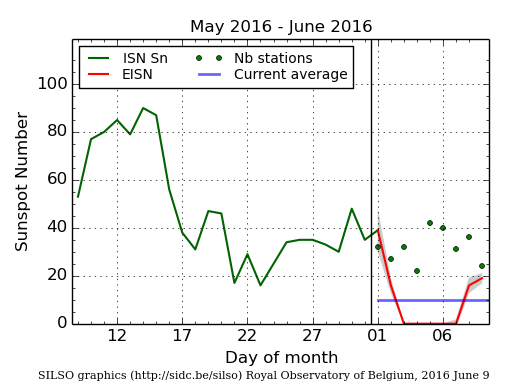
The daily Estimated International Sunspot Number (EISN, red curve with shaded error) derived by a simplified method from real-time data from the worldwide SILSO network. It extends the official Sunspot Number from the full processing of the preceding month (green line). The plot shows the last 30 days (about one solar rotation). The horizontal blue line shows the current monthly average, while the green dots give the number of stations included in the calculation of the EISN for each day.
Review of geomagnetic activity
The solar wind was at nominal levels for most of the week, till the solar wind was disturbed due to the influence of high speed stream from June 5 on. The solar wind speed started the week at about 550 km/s, gradually declined to 300 km/s, till it increased again on June 5 up to about 600 km/s. The magnetic field was around 5 nT till it jumped with a maximum of about 20 nT.
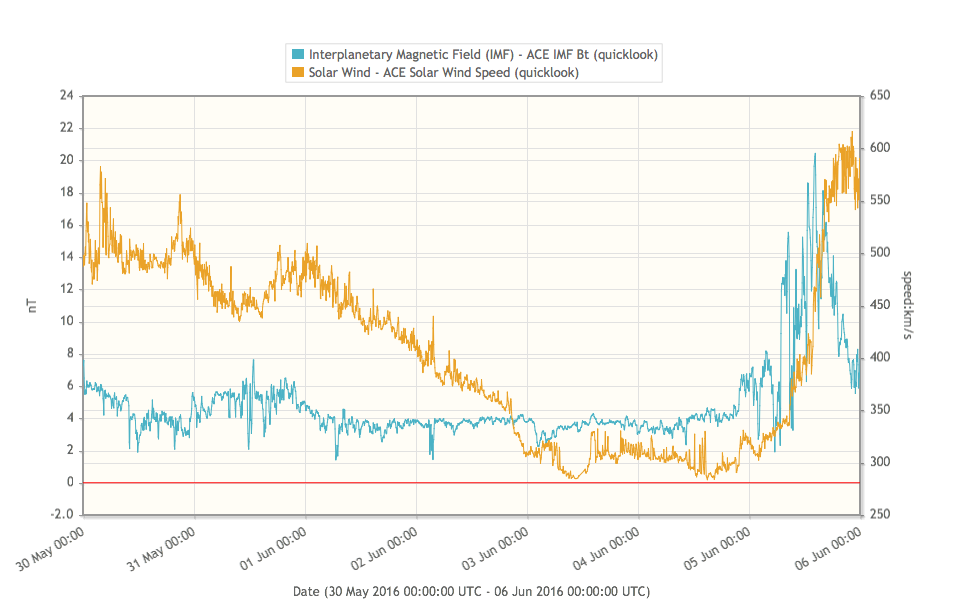
Geomagnetic conditions mostly were quiet, till the solar wind disruption resulted in a minor to major geomagnetic storm (K=5 at local level, K=6 at estimated global Potzdam and NOAA Kp).
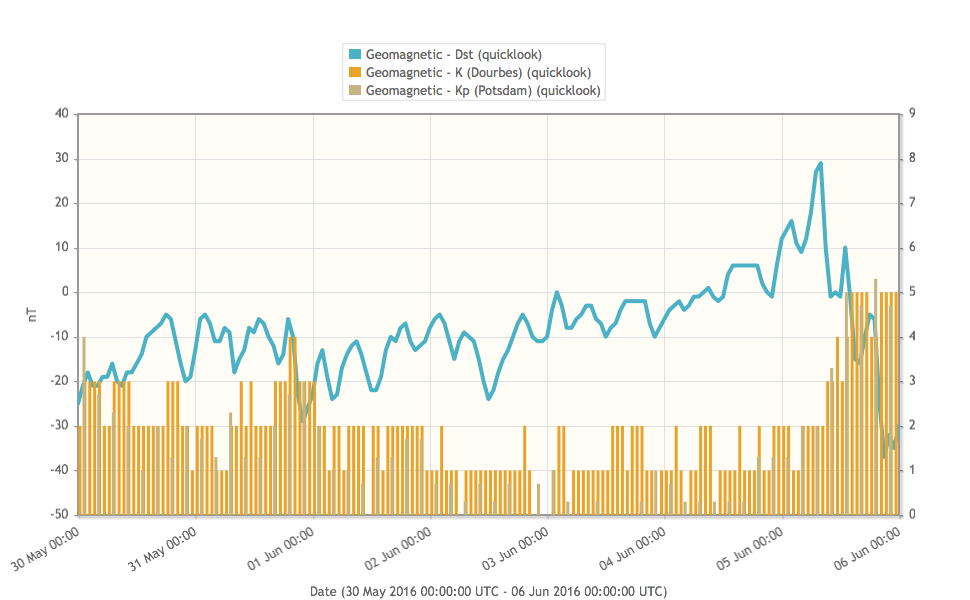
Review of ionospheric activity (30 May 2016 - 5 Jun 2016)
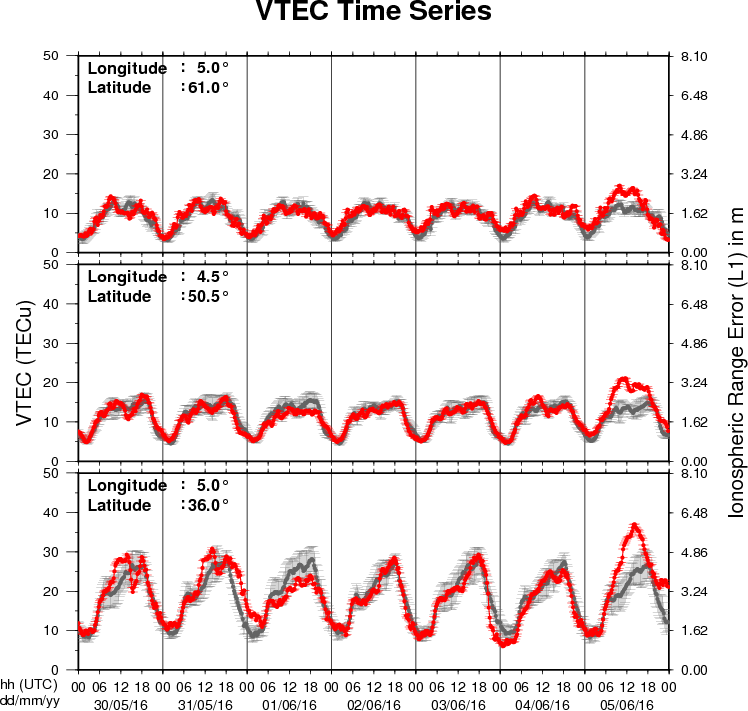
The figure shows the time evolution of the Vertical Total Electron Content (VTEC) (in red) during the last week at three locations:
a) in the northern part of Europe(N61°, 5°E)
b) above Brussels(N50.5°, 4.5°E)
c) in the southern part of Europe(N36°, 5°E)
This figure also shows (in grey) the normal ionospheric behaviour expected based on the median VTEC from the 15 previous days.
The VTEC is expressed in TECu (with TECu=10^16 electrons per square meter) and is directly related to the signal propagation delay due to the ionosphere (in figure: delay on GPS L1 frequency).
The Sun's radiation ionizes the Earth's upper atmosphere, the ionosphere, located from about 60km to 1000km above the Earth's surface.The ionization process in the ionosphere produces ions and free electrons. These electrons perturb the propagation of the GNSS (Global Navigation Satellite System) signals by inducing a so-called ionospheric delay.
See http://stce.be/newsletter/GNSS_final.pdf for some more explanations ; for detailed information, see http://gnss.be/ionosphere_tutorial.php
Future Events
For more details, see http://www.spaceweather.eu/en/event/future
The Scientific Foundation of Space Weather
Start : 2016-06-27 - End : 2016-07-01
Website:
http://www.issibern.ch/program/workshops.html
Global Modelling of the Space Weather Chain in Helsinki, Finland
Start : 2016-10-24 - End : 2016-10-28
This event brings together solar, heliospheric, magnetospheric,
and ionospheric communities to discuss the current state and future
challenges in global modelling of the entire space weather chain.
Major developments in forecasting space weather, and understanding
the effects of solar eruptions requires increased communication and
collaboration of these often rather distinct communities. We
welcome submissions from these modelling communities and also
synergetic studies utilising both observations and numerical
models.
Website:
https://pnst.ias.u-psud.fr/sites/pnst/files/global_modelling_space_weather_oct2016.pdf
European Space Weather Week in Ostend, Belgium
Start : 2016-11-14 - End : 2016-11-18
The ESWW is the main annual event in the European Space Weather
calendar. It is the European forum for Space Weather as proven by
the high attendance to the past editions. The agenda will be
composed of plenary/parallel sessions, working meetings and
dedicated events for service end-users. The ESWW will again adopt
the central aim of bringing together the diverse groups in Europe
working on different aspects of Space Weather.
Website:
http://www.stce.be/esww13/
Solar Orbiter Workshop 7: Exploring the solar environs in Granada, Spain
Start : 2017-04-03 - End : 2017-04-06
This event will be hosted by the Instituto de Astrofisica de
Andalucia - CSIC. Please mind that on April 7th the 20th SWT
meeting will take place at the same venue.
Website: Unkown
New documents in the European Space Weather Portal Repository
See http://www.spaceweather.eu/en/repository
STCE - Cosmic Rays workshop: A brief history of the cosmic ray monitoring at RMI
Presentation given at the Cosmic Rays workshop
Check https://events.oma.be/indico/event/10/
http://www.spaceweather.eu/en/repository/show?id=602
STCE - Cosmic Rays workshop: Introduction and Research topics
Presentation given at the Cosmic Rays workshop
check https://events.oma.be/indico/event/10/
http://www.spaceweather.eu/en/repository/show?id=603
STCE - Cosmic Rays workshop: The Neutronminitor database (NMDB) and its applications to space weather
Presentation given at the Cosmic Rays workshop
check https://events.oma.be/indico/event/10/
http://www.spaceweather.eu/en/repository/show?id=604
STCE - Cosmic Rays workshop: GLE alerts as input for SEP forecasts
Presentation given at the Cosmic Rays workshop
check https://events.oma.be/indico/event/10/
http://www.spaceweather.eu/en/repository/show?id=605
STCE - Cosmic Rays workshop: Cosmic rays and dosimetry at aviation altitudes
Presentation given at the Cosmic Rays workshop
check https://events.oma.be/indico/event/10/
http://www.spaceweather.eu/en/repository/show?id=606
STCE - Cosmic Rays workshop: Radiation hazards for astronauts
Presentation given at the Cosmic Rays workshop
check https://events.oma.be/indico/event/10/
http://www.spaceweather.eu/en/repository/show?id=607
